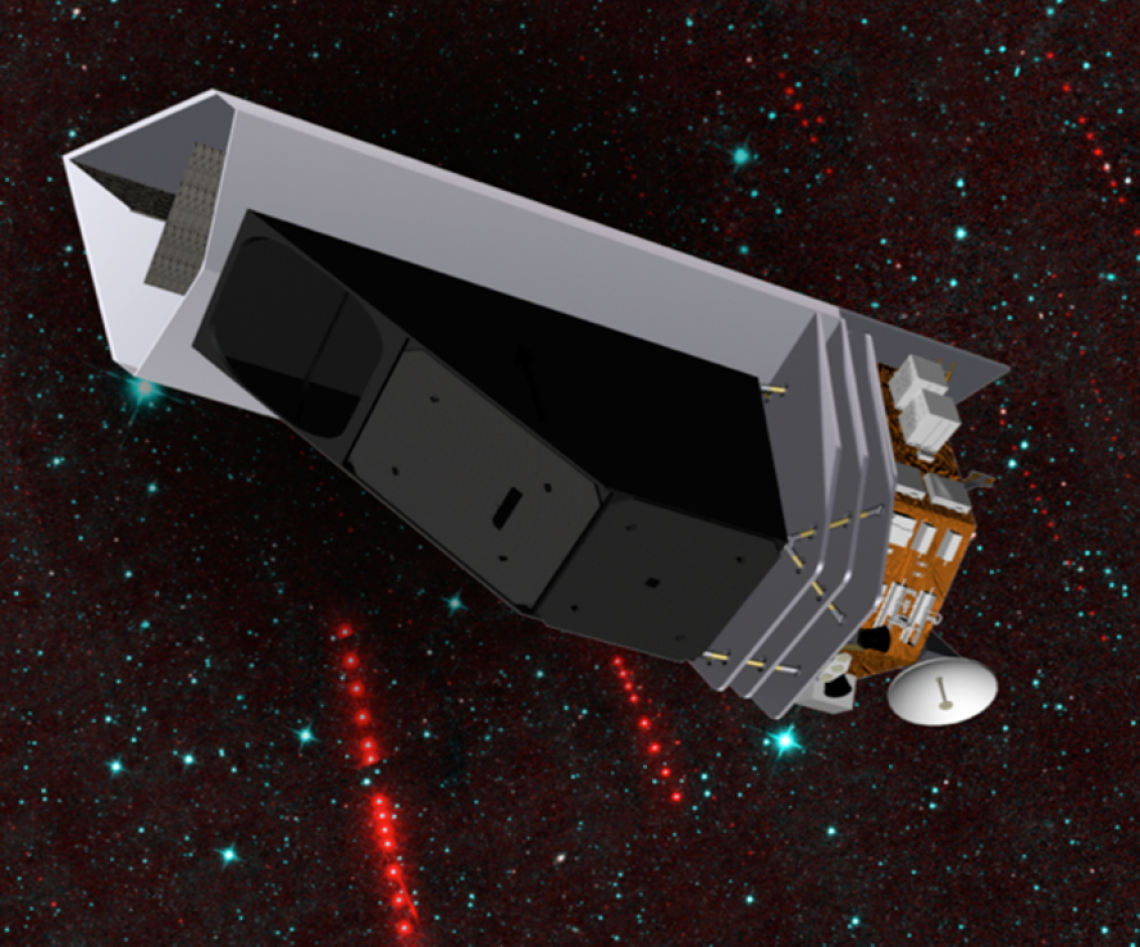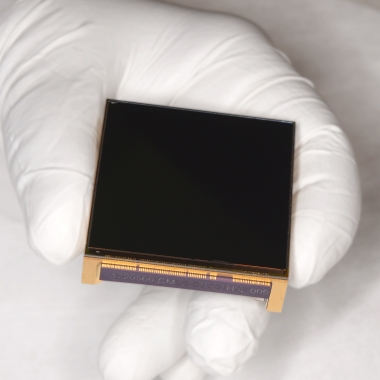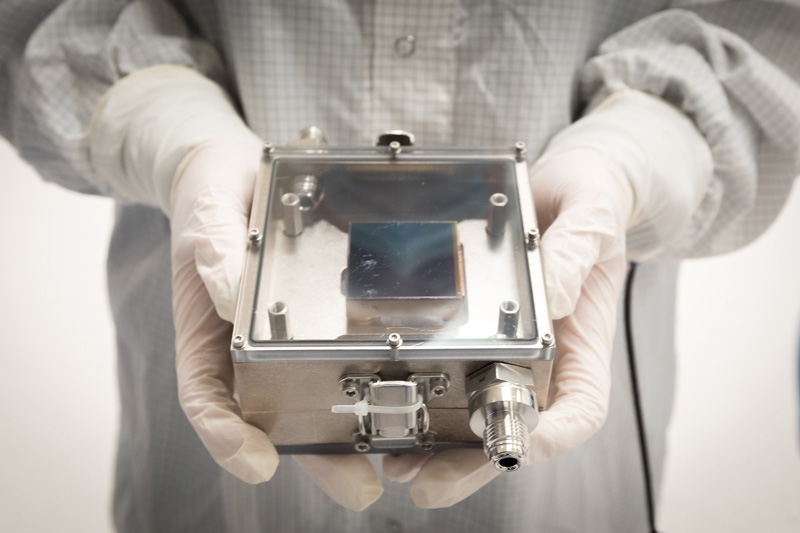UArizona to Lead Mission to Discover Potentially Dangerous Asteroids
NASA has tasked Amy Mainzer, an expert in infrared astronomy at the University of Arizona, with leading NEO Surveyor, a mission to find, track and characterize yet unseen asteroids and comets that may pose a threat to Earth.

The NEO Surveyor infrared space telescope is optimized for finding, tracking and characterizing potentially hazardous asteroids and comets. The spacecraft’s sunshade (silver vertical part) blocks out sunlight and keeps the telescope shielded so that it can search for the faint heat signatures from Earth-approaching objects. The asteroids will appear as strings of dots (color-coded red in the background image) that will stand out against the background stars (color-coded blue).NASA/JPL
A new mission to find, track and characterize asteroids and comets that may pose a threat to Earth has moved one step closer to launch. Led by Amy Mainzer, a professor in the University of Arizona's Lunar and Planetary Laboratory, the Near-Earth Object Surveyor mission has been approved by NASA to begin its preliminary design phase.
NEO Surveyor is an infrared space telescope designed to help advance NASA's planetary defense efforts by expediting our ability to discover and characterize most of the potentially hazardous asteroids and comets that come within 30 million miles of Earth's orbit. These asteroids and comets are collectively known as near-earth objects, or NEOs.
"The fact that NASA tasked Dr. Mainzer and her group with the scientific leadership of this mission is a direct testament to her incredible leadership and expertise, as well as our university's strong foundation in infrared astronomy, led by Marcia and George Rieke at Steward Observatory, and our strengths in asteroid science, as with the OSIRIS-REx sample return mission," said University of Arizona President Robert C. Robbins. "With NEO Surveyor, we are embarking on a project that transcends basic research and directly tackles one of humankind's grand challenges: keeping our planet safe from devastating asteroid impacts."
Following completion of the goal to discover 90 percent of all NEOs larger than 1,000 meters (3,280 feet) in size in 2010, Congress directed NASA to discover 90 percent of NEOs larger than 140 meters (459 feet) in size. NEO Surveyor is being designed to meet this goal within a decade of its launch date.
"We think there are about 25,000 NEOs large enough to wipe out an area like Southern California," Mainzer said. "Once they get bigger than about 450 feet in diameter, they can cause severe regional damage. We want to find these, and as many smaller ones as possible."
 Ongoing programs tasked with finding asteroids, such as UArizona's Catalina Sky Survey, have discovered about 40% of such objects, and they continue to be successful at finding more. However, because infrared observations are extremely difficult to make with Earth-based telescopes and many asteroids are extremely faint in visible wavelengths of light, it would take decades to find the remainder of these objects. This is where NEO Surveyor and its highly sensitive heat-sensing cameras come in.
Ongoing programs tasked with finding asteroids, such as UArizona's Catalina Sky Survey, have discovered about 40% of such objects, and they continue to be successful at finding more. However, because infrared observations are extremely difficult to make with Earth-based telescopes and many asteroids are extremely faint in visible wavelengths of light, it would take decades to find the remainder of these objects. This is where NEO Surveyor and its highly sensitive heat-sensing cameras come in.
"Earth-approaching asteroids and comets are warmed by the sun, and they give off heat that the NEO Surveyor mission will be able to pick up," Mainzer said. "Even asteroids as dark as a chunk of coal won't be able to hide from our infrared eyes."
NEO Surveyor is designed to rapidly accelerate progress in finding these objects, as well as finding a large number of smaller objects that could still cause great harm to cities. The mission will obtain enough observations to discover NEOs and determine their orbits.
 Searching for asteroids by sensing their heat emission allows astronomers to not only detect their position and movement in space, but also to compute the sizes of the objects.
Searching for asteroids by sensing their heat emission allows astronomers to not only detect their position and movement in space, but also to compute the sizes of the objects.
"Impact energy depends heavily on how big an individual asteroid is, so the infrared observations delivered by NEO Surveyor will greatly expand our ability to predict the behavior of some of Earth's neighbors that could be on a trajectory to pay us a surprise visit," Mainzer said.
The University of Arizona is providing scientific leadership of the overall mission, building and testing the flight infrared detector assemblies, monitoring the observatory's performance, managing the investigation team and supporting operations after it is launched. Specifically, Mainzer's research group will deliver a key piece of hardware for the new telescope: a total of eight infrared camera detectors, each with 4 megapixels of resolution, which allow the telescope to spot the tiny, glowing spots marking the positions of asteroids and comets as they move across the sky.
Because it senses the heat from NEOs, the NEO Surveyor telescope, which will be about 20 feet long, will go into the cold space environment provided by an orbit that takes it outside the Earth's moon. From this vantage point, the observatory will continuously scan the sky, particularly the regions near the sun where asteroids with the most Earthlike orbits spend much of their time.
In addition to selecting and testing the flight detector chips, Mainzer's group will produce detailed simulations of the observatory's performance and will generate the scan pattern that the telescope will follow once it is in space.
 “The university's leading roles in infrared astronomy and asteroid science make it uniquely suited to leading this next-generation infrared sky survey,” said Elizabeth "Betsy" Cantwell, senior vice president for research and innovation at UArizona.
“The university's leading roles in infrared astronomy and asteroid science make it uniquely suited to leading this next-generation infrared sky survey,” said Elizabeth "Betsy" Cantwell, senior vice president for research and innovation at UArizona.
UArizona has delivered instruments for NASA missions such as the Hubble and Spitzer space telescopes, as well as the upcoming James Webb Space Telescope. Mainzer is the lead scientist of a smaller Earth-orbiting telescope that characterizes NEOs, called the Near-Earth Object Wide-field Infrared Surveyor, or NEOWISE. NEOWISE serves as a key precursor mission for the NEO Surveyor, which will greatly expand NASA's ability to find Earth-approaching asteroids and comets.
"With NEO Surveyor, we want to spot potentially hazardous NEOs when they're years to decades away from possible impact," Mainzer said. "The whole idea is to provide as much time as possible to develop mitigation efforts that enable us to push them out of the way."
The NEO Surveyor mission is a joint project of the University of Arizona and NASA's Jet Propulsion Laboratory, or JPL, supported by NASA's Planetary Science Division. Other major partners include Ball Aerospace (Colorado); Space Dynamics Lab (Utah); Teledyne (California); L3 Harris (Massachusetts); University of Rochester (New York); IPAC (California); Planetary Science Institute (Arizona) and the University of California, Los Angeles.

